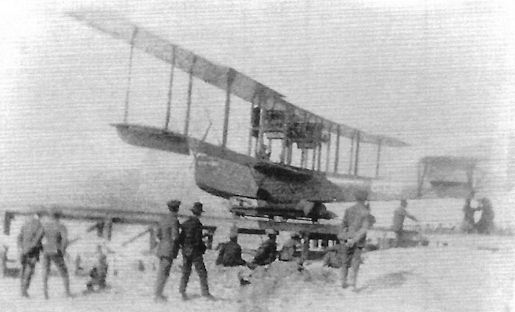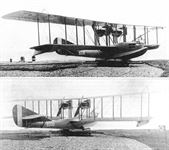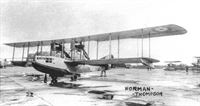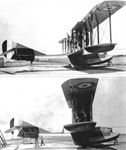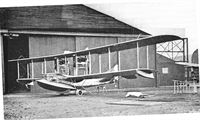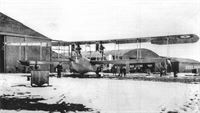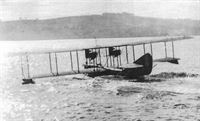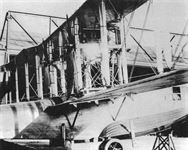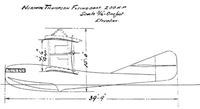G.Duval British Flying-Boats and Amphibians 1909-1952 (Putnam)
Norman Thompson N.T.4 and N.T.4A (1915)
On 4 October, 1915, the White and Thompson Company changed its name to the Norman Thompson Flight Company, Ltd, with F. P. H. Beadle as chief designer. The first machine to appear under the new name was the N.T.4. A development of the twin-engined Round Britain Race entrant of 1914, the N.T.4 was ordered for R.N.A.S. use, becoming known as the ‘America’ flying-boat, and later, with the introduction of the Curtiss H.12, as the ‘Small America’ although there was little resemblance between the Norman Thompson and Curtiss machines. It should be noted that at this time there was a confusing tendency to class all flying-boats as ‘Americas’, regardless of type or manufacture.
A biplane, with twin 150 h.p. Hispano-Suiza pusher engines driving two- bladed propellers, the N.T.4 had two side-by-side seats in an enclosed cabin. The hulls were made by S. E. Saunders at Cowes. The first production machine of a batch of six, No. 8338, was experimentally fitted with a two-pounder Davis gun mounted horizontally above the cabin roof. This gun was subsequently removed, not having been used operationally. Commencing with the second production batch, the N.T.4s had modified cabin windows to give better vision, and were fitted with 200 h.p. Hispano-Suiza engines. With these modifications the machines were designated N.T.4A, the first one, No. 9061, being stationed at Calshot. A total of over fifty machines of both versions served with the R.N.A.S. at seven coastal stations, where they were employed for patrols, and later for training duties.
SPECIFICATION
Power Plant:
N.T.4 - Two 150 h.p. Hispano-Suiza engines
N.T.4A - Two 200 h.p. Hispano-Suiza engines
Span: 78 feet 7 inches
Length: 41 feet 6 inches
Loaded: N.T.4A-6,469 pounds
Total Area: 936 square feet
Max. Speed: N.T.4A-95 m.p.h.
Endurance: 4 hours
Armament: Light bombs, .303-inch Lewis gun in cabin roof
Norman Thompson N.2C (1918)
The Norman Thompson N.2C was a 1918 development of the N.T.4A. The wings and tail unit were standard N.T.4A components, but unlike the previous boat-built hulls characteristic of this company, the N.2C had a hull built on the Porte principle. Norman Thompson had been contractors for F.2A hulls since the spring of 1917, and so were familiar with the Porte-type construction. The power units were two pusher Sunbeam Arab engines of 200 h.p. each, driving four-bladed propellers. Construction of two prototypes commenced in January 1918. These were officially serialled N82 and N83, but the machines, designed for patrol work and equipped with Lewis guns, bombs, and wireless, arrived too late for production or service, being scrapped due to post-war economy upon the take-over by Handley Page, Ltd.
SPECIFICATION
Power Plant: Two 200 h.p. Sunbeam Arab
Span: 78 feet 7 inches
Length: Not available
Weight Loaded: 6,700 pounds
Total Area: 936 square feet
Armament: One or two Lewis guns, light bombs
Показать полностью
J.Bruce British Aeroplanes 1914-1918 (Putnam)
Norman Thompson N.T.4 and N.T.4a
IN March 1915, the Admiralty ordered fifty flying-boats of the type which became well known as the Curtiss H.4, or more popularly as the “America”. When fitted with satisfactory engines these Curtisses gave quite a good account of themselves and proved that flying-boats could be of use in warfare.
On October 4th, 1915, the name of the White and Thompson company was changed to the Norman Thompson Flight Co., Ltd. The first aircraft to appear under the new name was a handsome twin-engined flying-boat of the same general type as the Curtiss H.4. Either because it was the fourth flying-boat design of the Bognor company or because it was desired to retain the numeral of the Curtiss type’s designation as indicative of a class of flying-boat, the new machine was designated N.T.4.
Like the Curtiss H.4, the Norman Thompson N.T.4 was known in the R.N.A.S. as an “America” or, after the introduction of the Curtiss H.12, as a “Small America”. There was, however, no real connexion between the two flying-boats, and the N.T.4 differed from the Curtiss type in several major respects. It was larger, had four-bay wings and a different hull, and was driven by pusher engines instead of the tractors of the Curtiss H.4.
The hull was a boat-built structure rather similar to the Curtiss hull but with finer lines. It had only one step, and the size and form of the hull fins recalled Curtiss practice, but a shallow and stubby forebody was used. Enclosed accommodation was provided for the crew, but the early form of cabin did not have as much glazing as would have seemed necessary; even the vertical windows had very wide framing to reduce the view further.
The wings were of unequal span, but the extensions of the upper mainplanes were comparatively short; they were braced by cables, the landing wires running from king-posts above the outermost interplane struts. The ailerons of the first few N.T.4s projected behind the trailing edge of the upper wing, to which they were fitted.
These first machines were powered by two 150 h.p. Hispano-Suiza engines installed as pushers and driving two-bladed airscrews. The engines were completely uncowled, and each had a large rectangular radiator mounted on the forward interplane struts. A small gravity fuel tank was mounted between the central struts, high up near the upper wing.
The first N.T.4 of the first batch, No. 8338, was experimentally fitted with a two-pounder Davis gun. The gun was carried on a substantial horizontal mounting which was built above the cabin top. Supporting struts ran downwards through a cabin window on either side. The Davis gun was officially abandoned as a weapon, however, and never became standard armament for the N.T.4.
N.T.4s of the second and all subsequent batches differed from the early machines in having more powerful engines. These were two of the 200 h.p. geared Hispano-Suizas, and with them the flying-boat was designated N.T.4a. The design of the cabin was successively modified to provide more transparency, and the final production version had all-over glazing of the cabin top. The gravity fuel tank was raised by placing it on top of the upper wing. For starting, fuel was pumped up to the gravity tank by hand, and once the N.T.4a was airborne the supply was maintained by two wind-driven pumps on top of the hull.
In the later N.T.4a’s the ailerons were reduced in chord to bring their trailing edges flush with that of the upper mainplane; and the lower portion of the rudder was covered with plywood, for it was frequently awash. All the N.T.4s and N.T.4a’s were characterised by the same tail-unit, which incorporated a large low aspect-ratio fin and plain broad-chord rudder; the tailplane was mounted half-way up the fin, and was braced to the hull by struts.
The Norman Thompson N.T.4a was quite widely used by the R.N.A.S. in home waters, presumably as a patrol machine and latterly as a trainer. It had quite a good performance, and probably would have made something of a name for itself if its appearance had not coincided so closely with the advent of the “Large America” types. Production continued into the summer of 1918, when it was hoped that the N.T.4a would be replaced by the Norman Thompson N.2C, a later design which incorporated N.T.4a flight organs.
SPECIFICATION
Manufacturers: The Norman Thompson Flight Co., Ltd., Bognor Regis, Sussex.
Power: Two 150 h.p. Hispano-Suiza; two 200 h.p. Hispano-Suiza.
Dimensions: Span: upper 78 ft 7 in., lower 60 ft 10 in. Length: 41 ft 6 in. Height: 14 ft 10 in. Chord: 7 ft 6 in. Gap: 7 ft 6 in. Stagger: 8 1/2 in. Dihedral: 1° 30'. Incidence: 5°. Span of tail: 16 ft.
Areas: Wings: upper 518 sq ft, lower 418 sq ft, total 936 sq ft. Ailerons: each 30-9 sq ft, total 61-8 sq ft. Tailplane: 75 sq ft. Elevators: 61-5 sq ft. Fin: 24 sq ft. Rudder: 31-9 sq ft.
Weights and Performance (for 200 h.p. engines): Date of Trial Report: September 24th, 1917. Type of airscrews used on trial: D.1062. Weight empty: 4,572 lb. Military load: 273 lb. Crew: 540 lb. Fuel and oil: 1,084 lb. Loaded: 6,469 lb. Maximum speed at 2,000 ft: 95 m.p.h.; at 6,500 ft: 93 m.p.h.; at 10,000 ft: 91 m.p.h. Climb to 2,000 ft: 3 min 50 sec; to 6,500 ft: 15 min; to 10,000 ft: 31 min 5 sec. Service ceiling: 11,700 ft.
Armament: Uncertain. Probably a Lewis machine-gun would be fitted on a bracket above the cabin, and bombs might be carried under the lower wings. An experimental installation of a two-pounder Davis recoilless gun was made in one N.T.4.
Service Use: Used at R.N.A.S. Stations, Calshot, Cattewater, Dundee, Felixstowe, Killingholme, Invergordon, Scapa Flow.
Production: Serial numbers were allotted for at least fifty N.T.4s and N.T.4a’s.
Serial Numbers: 8338-8343. 9061-9064. N.2140-N.2159. N.2740-N.2759. 9061 was flown at Calshot.
Costs:
Airframe without engines, instruments or armament £3,610
200 h.p. Hispano-Suiza engine (each) £1,004
Norman Thompson N.2C
THE Norman Thompson N.2C was a 1918 development of the N.T.4a. It consisted of the wings and tail-unit of the N.T.4a fitted to a hull which was built on the Porte principle instead of being boat-built, and the type was intended to be a replacement for the N.T.4a. The Norman Thompson company had been contractors for hulls for F.2A flying-boats since the spring of 1917, and were therefore familiar with the system of construction.
It was perhaps fortunate that the hull of the N.2C was such a simple structure, because F. P. H. Beadle had left the Norman Thompson company at the end of 1917. His experience had been a considerable asset to the company in the production of their earlier flying boats.
Construction of two prototypes began in January 1918. The hull was basically a cross-braced girder structure, plywood-covered and generally similar to the hulls of the F-boats. The wings appeared to be standard N.T.4a surfaces. The rudder differed in shape from that of the N.T.4a, probably because the N.2C hull had a much shorter stern-post. Power was provided by two Sunbeam Arab engines driving four-bladed pusher airscrews.
The Norman Thompson N.2C was intended for patrol duties and was equipped with wireless, guns and bombs. The prototypes were completed, but the type arrived too late to go into production or to see service.
SPECIFICATION
Manufacturers: The Norman Thompson Flight Co., Ltd., Bognor Regis, Sussex.
Power: Two 200 h.p. Sunbeam Arab.
Dimensions: Span: upper 78 ft 7 in., lower 60 ft 10 in. Chord: 7 ft 6 in. Gap: 7 ft 6 in.
Areas: Wings: 936 sq ft.
Serial Numbers: N.82-N.83.
Показать полностью
H.King Armament of British Aircraft (Putnam)
Norman Thompson
N.T.4 and 4a. The first N.T.4 twin-engined pusher flying-boat (1917) had a 2-pdr Davis recoilless gun mounted above the enclosed cockpit in the nose. The mounting was braced by lateral struts running downward through the cockpit. Later a Lewis gun may have been carried by aircraft of this type. For anti-submarine work a maximum load of two 100-lb bombs appears likely.
N.1B. A two-seater, this fighter flying-boat was probably intended to carry a Lewis gun for the observer's use.
N.2C. Developed in 1918 primarily for patrol, this flying-boat probably carried a Lewis gun, and perhaps bombs also.
Показать полностью
O.Thetford British Naval Aircraft since 1912 (Putnam)
Norman Thompson N.T.4
The Norman Thompson N.T.4 is perhaps the least known of all the large flying-boats employed on coastal patrol by the RNAS in the First World War. It never enjoyed the fame that attended the American Curtiss boats, or the Felixstowe series, but nevertheless was responsible for a good deal of routine anti-submarine reconnaissance from a string of bases between Calshot and Scapa Flow.
The N.T.4 was the first new design to appear after the old White and Thompson Company changed its name to the Norman Thompson Flight Company in October 1915, and its emergence coincided with the Curtiss H.4. For this reason, in the somewhat haphazard custom of those days, it was known by the name of 'America', and later changed to 'Small America', in the same way as the Curtiss. This may account for the obscurity in which its operational record is shrouded, as there may have been some confusion between the two types in official archives.
A feature of the N.T.4 was the completely enclosed accommodation for the crew. In the earlier version the view was poor and the cabin was progressively improved, so that in the late production models the cabin-top was glazed as well as the sides.
The first batch of aircraft (Nos.8338 to 8343) were fitted with two 150 hp Hispano-Suiza engines. Subsequent machines had 200 hp geared Hispanos, were designated N.T.4A and were allotted the serial numbers 9061 to 9064 and N2140 to 2159. Production ceased in the summer of 1918 after 30 had been built.
One of the N.T.4 flying-boats (No.8338) was the subject of an interesting experiment in armament. It was fitted with a Davis two-pounder recoilless gun mounted above the cabin. The installation was never embodied in production aircraft.
UNITS ALLOCATED
RNAS coastal air stations at Calshot, Cattewater. Dundee, Felixstowe, Invergordon, Killingholme and Scapa Flow.
TECHNICAL DATA (N.T.4A)
Description: Anti-submarine reconnaissance flying-boat with a crew of four. Wooden structure, with wood and fabric covering.
Manufacturers: Norman Thompson Flight Co Ltd, Bognor Regis, Sussex.
Power Plant: Two 200 hp Hispano-Suiza.
Dimensions: Span, 78 ft 7 in. Length, 41 ft 6 in. Height, 14 ft 10 in. Wing area, 936 sq ft.
Weights: Empty, 4,572 lb. Loaded, 6,469 lb.
Performance: Maximum speed, 95 mph at 2,000 ft; 91 mph at 10,000 ft. Climb, 3 min 50 sec to 2,000 ft; 31 min 5 sec to 10,000 ft. Service ceiling, 11,700 ft.
Armament: Possibly provision for free-mounted Lewis gun firing through a side window and racks for bombs beneath lower wings.
Показать полностью
C.Owers The Fighting America Flying Boats of WWI Vol.1 (A Centennial Perspective on Great War Airplanes 22)
5. The Norman Thompson N.T.4 Small America Flying Boats
Norman Thompsons company, White and Thompson Ltd, gained the exclusive rights to sell Curtiss aeroplanes and engines in the UK in 1913. These rights were not given up and the actions of John Porte in obtaining commissions for the sale of Curtiss aircraft to the RNAS was not only contrary to regulations, but was an infringement of Thompsons rights. White and Thompson started to build a twin engined flying boat for the Daily Mail “Circuit of Britain” race. This machine was apparently based on the Curtiss flying boat that Glenn Curtiss had brought to Britain in 1913, an F-Boat with the ailerons mounted in the upper wing and not in the usual position between the wings.
The White and Thompson No.1, as the “Circuit of Britain” boat was designated, was impressed on the outbreak of war and allocated the serial 883, however no record of its use by the RNAS has been discovered to date. The company was successful in selling its N.T 2 and N.T 2a small flying boat trainers to the Admiralty. Not so successful was the company’s attempt to develop a “Small America” type.
The company was renamed the Norman Thompson Flight Company in September 1915, the new company obtaining an order for six twin engined flying boats in December 1915. The new machine was also known as an “America” type although the hull owed little to Curtiss and more to Percy Beadle, rhe company’s designer. Designated N.T.4 the machine was to be powered by two 100-hp Green straight-six engines installed as pushers. Realising that these had inadequate power two 140-hp Hispano-Suiza V-eight engines were substituted, this involving a complete redesign of the engine installation. According to testimony given at the post-war claim for compensation by Norman Thompson, the first boat was ready for trial in May 1916, “but it was found that it would not rise from the water owing to the engine not being strong enough, and owing to the high resistance of the water occasioned by the prow being so bluff...Of course the thing was of no use and accordingly work was stopped by order of the Admiralty.”
The N.T.4 was a twin-engined biplane with the engines installed as pushers. The top wing was of longer span than the lower and the extensions were braced from kingposts on the upper wing. The hull of the N.T.4 was skinned diagonally with mahogany ply strips held in place by copper rivets. Calico fabric was then placed and glued to the hull and another layer of ply applied as a final layer. The fins were built separately and added after the hull was completed. A fully enclosed cockpit was provided and this was modified as the hull design progressed to the N.T.4A. Lower wing tip floats were provided as well as a bumper at the end of the hull to provide protection when on land. The machine had a single step and the rear hull was circular in section. The nose was blunt and rose vertically to the large glass enclosed cockpit and this gave the machine a pugnacious.
Post-war the Norman Thompson Flight Co Ltd made a claim for compensation due to the circumstances that arose under Contract C.P.145936/15, dated 28 December 1915. Most of the information on the history of the N.T.4A flying boats comes from the files relating to these court actions. The Admiralty placed the order for the supply of ten America type flying boats at £3,250 each, these boats were to be fitted with twin 100-hp Green engines, with propellers, instruments, etc., to be supplied by the Admiralty. Delivery was to be as early as possible. The Admiralty paid 25% in advance to enable construction to proceed.
The boat was not built to the design submitted by the Company, “the prows of the flying boats were made bluffer than in Mr Norman Thompsons design, offering a greater surface of resistance to the water. Mr Norman Thompson himself pointed out that he did not consider that the 100 horse power engine would be sufficient for the purpose that was intended, which was the purpose of lifting the boats out of the water to fly.” In his testimony Thompson stated that the design was “very largely” that of the Admiralty, particularly the hull design. The order for the flying boats was “in the nature of an experiment and the order was given to this Company as being the only kind of Company that could carry it out.” The construction was commenced until it was held up due to the modifications ordered by the Admiralty owing to the unsatisfactory operation of the Green engine. Actual work on the boats had commenced before the signing of the contract and the boats were mainly completed when the order to cease was given. They were to be stored until the necessary modifications were tried on one boat and had proved successful. The Company was told to keep its staff intact during this period. Thompson tried to obtain other contracts to keep his staff actively employed but was not allowed any such contracts according to testimony presented post-war. In June a contract for 20 FBA flying boats (N1040 - N1059) was given to the Company. These were built under the Company designation N.T.5.
The work involved in order to modify the N.T.4A to take the 140-hp Hispano-Suiza engine included “disassembling wings and centre panels, redesigning, re-building and fitting eight sets of new engine mountings, strengthening trailing edge of wings in accordance with letter from Director of Air Services of June 15th to our Admiralty Inspector, Lieut-Rennie, R.N.V.R....As regards new radiators to suit the Hispano Suiza engines, we have only ordered four at present according to instructions received, pending a final decision from the Air Department as to their suitability and size.” On 22 November 1916, the Company wrote to the Admiralty that “the delay arising from the unsatisfactory operation of the engines originally specified and their subsequent replacement by another of 50 per cent greater power has already exceeded eight months and pending final instructions relative to the starting of the engines and the size of the radiators, we are still unable to finish satisfactorily the first machine for acceptance tests.... There are nine (machines) in our factory in various stages of assembly, but all are ready for prompt completion when their engines are received.” On 28 December the Admiralty accepted the quotation for altering “the America type Flying boats Nos 8338-8343 and 9061-9064” for the total sum of £2,216.
The Company was then informed that it was to “carry out the necessary alterations to the prows of the twin engined flying boats Nos 8338-8343 and 9061-9064...in order to prevent the boats taking in too much water. It is understood that you are in possession of all the necessary particulars to enable you to carry out the alterations. To avoid delay the work should be put in hand at once.” The modification was in the form of a short prow added to the hull giving the boats an unfinished appearance.
The hulls were sent in February or March 1917 to Killingholme where they were to be erected on receipt of their engines. “The wing gear and flight organs had to remain stored in the Company’s Works, as there was no suitable dry storage room at Killingholme.” This took up a lot of the floor space of the erecting shop “and we are working under considerable difficulties.” The machines were not complete until April 1918, when the Company had to send the stored parts and some of their employees to Killingholme to erect the machines. The post-war claim was for lost production due to having to store the hulls and aircraft parts.
The change in engines delayed the completion of the boats and it was October 1916 before the prototype, 8338, flew. Delays continued. It was reported in a meeting on 14 August 1917, that 8339 and 8340 were awaiting acceptance tests. 8339 was due to be tested that morning but the latter would not be ready for another week. The NT-4 was stated to “have a rather high performance but are not very strong, the hulls having proved to be weak.” It was suggested that the hulls be strengthened as this would not be a detriment in a machine meant for training. It was decided that the machines be strengthened and the fitting for carrying two 230-lb bombs be stopped. The NT-4 was to be a training machine only. Sir Austin Robinson noted that the H-12 was hard to land and with its weak hull required a lot of skill. The fact that no dual control was fitted to the H-12 meant that training was carried out on the “elderly H4s, or more often in the Norman Thompson NT4s which were regarded as expendable.” At one time 8338 had been fitted with a Davis Gun, the Admiralty continuing to pursue the use of this recoilless gun for most of the war. 8339 had been completed by December 1916 and had been fitted to carry two 230-lb bombs and when erected at Killingholme the bomb racks were included. This was recorded as making a two hour/130 mile “S Patrol” from Dundee on 4 May 1918. Capt Norman Woodward was stationed at Dundee and flew 8339 on 19 April when he spotted a submarine's swirl off Arbroath in misty weather, unfortunately they were unable to make an attack. This is probably as close as any of the N.T.4 boats came to active service. Woodward also recorded that 8340 had been modified on station with the hull fitted with large fins. Takeoff was improved but the machine was very tail heavy.
A second batch of four N.T.4 boats had been ordered on 28 December 1915. These were probably originally ordered as N.T.4 machines but were delivered as N.T.4A boats. A report from the Technical Department for the week ending 18 July 1917, indicated that the N.T.4 boats were still suffering problems. It was noted that the
Norman Thompson Flight Company, in connection with the installation of Hispano engines in small America Boat, No. N.T.4A, No. 9063. This machine has been flown twice and developed different troubles on each occasion. On its first flight the engine vibrated badly and cracked the pipe connections on the radiators, owing to the way in which the radiators were suspended; instructions were given to have this altered. The second flight took place after this alteration was carried out. No further trouble was reported from this cause, but trouble arose from the exhaust up-take breaking away and fouling the propeller causing much damage. The manifolds and up-takes have been strengthened and a further test is being made on the 13th July.
The Minute concluded by stating that a further report would be made after this test. A later report mentioned that slight repairs had to be made to the hull and control column and trials would commence on 28 July. The Meeting of 28 August noted that No. 9063 was “now ready to continue tests.” J.D. Rennie stated that the N.T.4A had the centre of gravity in the wrong place and its correction caused “much trouble.
Before the N.T.4A could enter service the Curtiss H-12 had proven to be a satisfactory flying boat, and the Felixstowe F.2A was to overcome the deficiencies of the H-12 and eventually replace it in service. There was no place for the N.T.4A even if it had proved successful. The later N.T.4A had a slightly modified hull and 200-hp Hispano-Suiza engines. The type could not be considered as a fighting machine and it is assumed that those delivered were intended for training purposes. Many were delivered straight into store.
8342 and 8343 are recorded at USN NAS Killingholme. The duo was delivered to the Killingholme Seaplane School for erection on 22 March 1917. It is assumed that they were used for training purposes when in the hands of the US Navy. Both were in store by January 1918 and written off by the British the following May.
An experimental boat was ordered in August 1917. This was to be a modification of the N.T.4A with the wings and tail surfaces of this boat but a new hull designed on Porte principles. It appears that at least two machines to meet the specifications were proposed. One employed two 200-hp Hispano engines but the firm did not think that this would meet the required performance and a second machine employing three engines was proposed as an alternative. The latter proposal was not proceeded with and this may be another instance where Norman Thompson had to amend its proposals in order to obtain a contract. A note in a Technical Department Report recorded that Beadle visited the Department with “amended proposals for a twin 200 h.p. Hispano Flying Boat to Air Board specification N.2.C. The design provided insufficient water clearance for the main planes and lower tail plane, the ailerons on the lower plane were also considered unsatisfactory.” Beadle was instructed to increase the height of the lower plane above the water line, increase the gap between the mainplanes; aileron on the upper planes only; and to substitute a monoplane tail in place of the present biplane tail in order to get the whole tail higher out of the water.
A later report states that the “firm is making satisfactory progress with the small twin-engined boat with reduced F.3 hull.” As Norman Thompson was building Porte designed F.2A hulls they were aware of the difference from the N.T.4A’s boat-built hull to those designed by Porte. Designated N.2C, two machines were ordered. The resultant flying boat was powered by two pusher 200-hp Sunbeam Arab engines. The contract for two “Boat Seaplane” to the N.2.C specification was reported as “situation unchanged” in the 70th Report of the Technical Department Aircraft Production for the three weeks ending 1 January 1919, and it was recommended that the two machines be cancelled.
Despite the problems, the work continued as documented in the fortnightly Reports of the Technical Department - Aircraft Production, Design Branch provide the following insights on the progress of the contract for the N.2C boats:
F/E 12.06.18. Norman Thompson Flight Co. Boat Seaplane. Two Arab. Contract for 2 machines. 1st machine: Awaiting engines. It is expected that these will be received during the next fortnight. Firm states that they can deliver this machine within 14 days from date of receipt of engines. 2nd machine: Work progressing slowly. Date of completion depends on delivery of engines.
F/E 26.06.18. 1st machine: Engines have now been received and Centre Section structure is erected. Tail and Fin are erected. Tanks are in. Work on main planes proceeding. Machine should be ready in a week. 2nd machine: Well ahead but waiting engines.
F/E 07.08.18. 1st machine: Is now complete and was taken out on August 1st for a trial. It was found that the tail section of the hull was too great. The machine rose to past the stalling angle before leaving the water. Steps are now being taken to remedy the fault. 2nd Machine: Proceeding slowly, awaiting results of No.1.
F/E 21.08.18. An officer has visited the firm and given detailed instructions as to deepening the rear step which it is thought will mitigate the tail suction trouble. This machine is 600 lb over weight on the firm’s estimate. The hull alone is 200 lb over weight.
F/E 04.09.18. 1st machine, No. N82. Necessary alterations are being made to rear step to mitigate tail suction trouble.
F/E 18.09.18. 1st machine, N82. The modifications to the step have been completed and the engine bearers are now being stabilised for vibration. Shortage of material will delay completion about ten days.
F/E 02.10.18. 1st machine, N82. Work has been held up awaiting channel iron to stiffen port engine bearers. This has now been received and the machine is expected to be ready for trials this week.
F/E 16.10.18. 1st machine, N82. Has now been flown by section Test Pilot. She is improved, but poepoises badly at 30 knots. In the air she proved very tail heavy, and could not be held at altitude with engine throttled down. A re-setting of the tail has been recommended. When this is done it is proposed to fly the machine to Grain for report and type trail. The process of further alterations at the firms works means great delay as they are very slow. 2nd Machine, N83. All components complete and the machine is awaiting the trials of N82.
F/E 20.10.18. 1st machine, N82. This machine is awaiting trial by Section Test Pilot. 2nd Machine, N83. Waiting results of N82.
F/E 13.11.18. N82. In abeyance, pending suggestions from firm after unsatisfactory trials. N83. Awaiting decision made on N82.
F/E 27.11.18. Situation remains unchanged.
F/E 11.12.18. Situation still unchanged.
Report for period 12 to 31.12.18. Situation unchanged. It has been recommended that these machines be deleted.
Report for Month ending 31.01.19. Machines N82 and N83. Recommended for deletion.
The first, N82, was trialed on 1 August 1918, and proved incapable of leaving the water as tail suction caused it to exceed its stall angle. While it was being modified work was stopped on N83, the second machine that was awaiting its engines. The rear step was deepened in order to overcome the problem with take-off but the seaplane now proved to be overweight. The machine again took to the air in October and was still unsatisfactory. The Armistice ended any further prospects of a production order.
Norman Thompson were no more successful with their N.T.6 “Cruiser Flying Boat, 3 Seated Tractor, 2 - 350 R.R.” that was proposed to meet the Air Department N.3b specification. On 9 May 1917, it was reported as in the design stage only. It was cancelled in 1917 before any work was put in hand. No further information is available for this design.
Norman Thompson was not successful in their efforts to obtain compensation from the Government post-war, nor were their claims against the Curtiss Company upheld. The company did receive £2,250 for their N.T.2, BN.T.2A, N.T.2b, N.T.3 and N.T.4 flying boats from the Royal Commission on Awards to Inventors. This was announced in the same issue of Flight that noted that Colonel J.C. Porte, for improvements in flying boats, and the Curtiss Aeroplane and Motor Co, for aircraft and hydro-aircraft, each received “nil”.
After the war there was a deal of discussion as to the best method of building flying boat hulls. In particular the Porte and Linton Hope methods were the two that were championed by two sides in what was a long running argument. The Curtiss method of hull building was not mentioned except that Maj J.D. Rennie in reply to a remark that in Porte’s time “experimental work was confined entirely to this type of boat. This is not the case, as one firm at least, The Norman Thompson Flight Co., were concentrating on flying boats at the same time. They had little success, as their hulls were of the old Curtiss type, which had many serious defects.”
N.T.4 Serial Allocations
Serial Number Type Contract Notes
8338 - 8343 6 N.T.4 CP145936/15 28.12.15.
9061 - 9064 4 N.T.4A * CP145936/15 28.12.15.
N2140 - N2159 20 N.T.4A AS 12528 (BR63) 17.05.17 N2140 delivered 1 July 1918. Most to store.
N2740 - N2759 20 N.T.4A AS32477 (BR225) 30.10.17. Cancelled June 1918.
N18 - N19 2 N.T.6 12.01.17. Air Cruiser. Cancelled 07.03.18.
N82 - N83 1 N.T.2C 02.04.18. To Specification N.2C. N83 never completed.
* Sturtivant & Page (Royal Navy Aircraft Serials and Units 1911-1919), state that the contract was for the N.T.4A. (P.152).
N.T.4 Specifications
Dimensions 1. N.T.4 Prototype 2. N.T.4A 3. N.T.4A
Span Upper 78 ft 0 in 77 ft 10 in 78 ft 7 in
Span Lower 64 ft 3 in 64 ft 3 in 60 ft 10 in
Chord 7 ft 6 in 7 ft 6 in 7 ft 6 in
Dihedral - 1°30’ -
Incidence - 5° -
Length 39 ft 9 in 40 ft 9 in 41 ft 6 in
Height 15 ft 0 in 14 ft 7 in 14 ft 10 in
Wing Area - 1,014 sq ft 997.8 sq ft
Weight Empty - - 4,572 lbs
Weight Loaded - - 6,469 lbs
Sources:
1. Air Department sketch. TNA AIR1/716/27/19/30.
2. Goodall, M.H. The Norman Thompson File, Air-Britain, UK, 1995.
3. Bruce, J.M. British Aeroplanes 1914-1918, Putnam, UK, 1957.
Показать полностью
